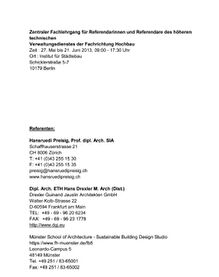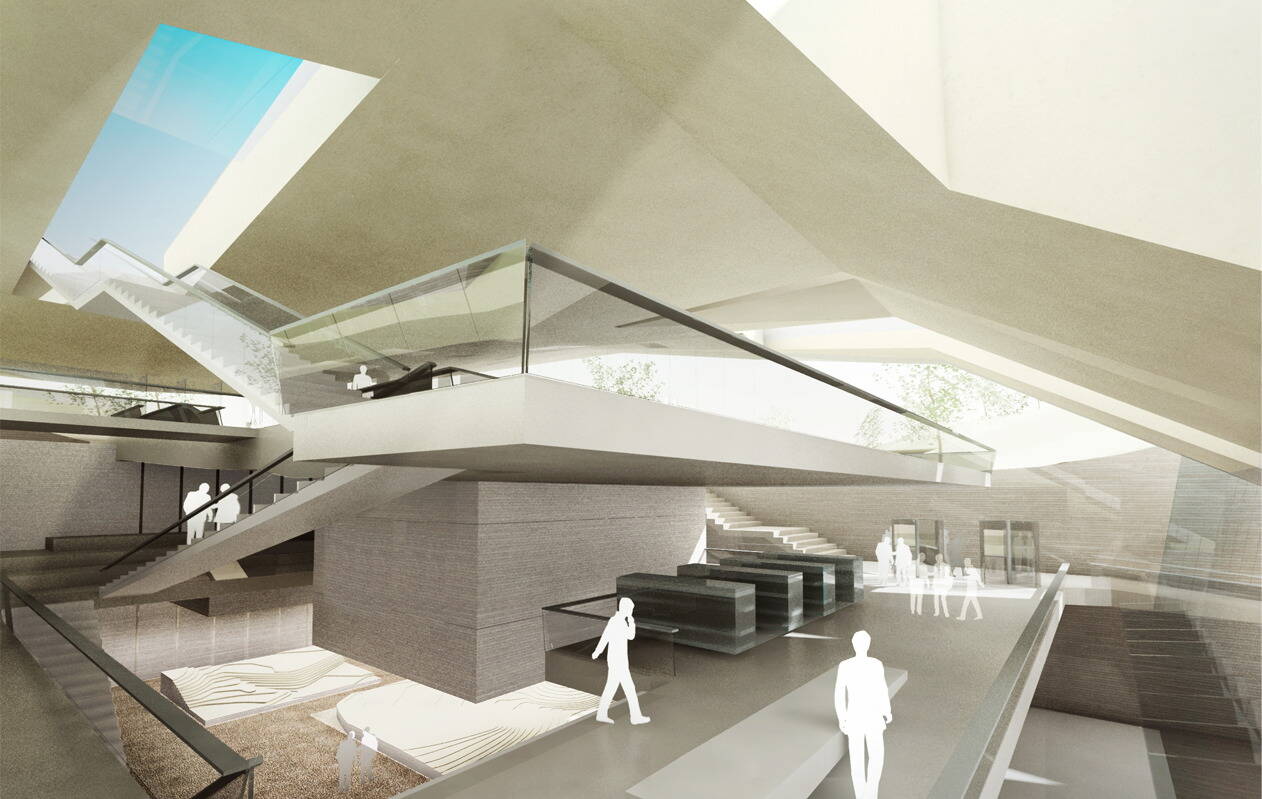 |
Well-Being and building monitoring in high efficiency residential buildingsprojectmedewerkers: DGJ architects, TU Braunschweig, University of Stuttgart, Humboldt University, AktivPlus eV, Berlin Institute for Social Research, Beibob media friends, VELUX Group gesteund door: BBSR - Bundesinstitut für Bau-, Stadt- und Raumforschung periode: 2014 - 2017 abstract: Buildings are not only technical equipment they are the living environment of People too. The interaction between buildings and people, therefore it can't be only describe on quantitative, structural-physical characteristics. The aim of this project is to get methods for describing user comfort, convenience and energy performance of buildings. To this end, it is developed a general applicable measurement instrument to describe and evaluate the user comfort in residential buildings (well-being). Here are three sources of data that are collected and compared: 1. Forecasts and simulations 2. Measurement of physical values 3. Survey of users |
|
AktivPlus Entwicklungsstandardprojectmedewerkers: Prof. Joost Hartwig, Hans Drexler, Prof. Dr. Natalie Eßig, Caroline Fafflok, Dr. Rolf-Michael Lüking, Dr.-Ing. Boris Mahler, Astrid Unger, Thomas Wilken gesteund door: AktivPlus e.V. - Walter-Kolb-Strasse 22 - 60594 Frankfurt periode: Jul 01 2013 - Dec 31 2016 abstract: "AktivPlus e.V." develops a standard for sustainable buildings and neighborhoods in the construction and property industry. This should be distinguished that AktivPlus optimize building energy consumption, energy and comfort and interaction with the user and thereby relieve infrastructure and the environment. |
||
BUILDING MONITORprojectmedewerkers: DGJ, VELUX Group, Technical University of Denmark (DK), AktivPlus e.V. (DE), Humboldt University, Berlin (DE), NetAtmo (FR), Beibob Medienfreunde Darmstadt (DE) gesteund door: Climate-KIC | The EU's main climate innovation initiative; www.climate-kic.org periode: 2015 - 2016 abstract: At the same time, awareness of the inhabitants about their energy consumption and how they can influence the building performance by their behaviour, will induce a long-term change of this behaviour. ‘Building monitor’ bridges this conceptual gap between building technology and the inhabitants. The aim of the project is to develop a standardised system to monitor buildings in respect of: · energy consumption · carbon emissions · indoor climate · well-being of the inhabitants This research project develops a ‘Building Monitor’ system for residential building with the following objectives: · Easy to install, use and understand. · Optimises energy use by improving understanding of the interaction between user comfort and building performance. · Gathers detailed information about energy consumption and indoor climate. · Provides a user interface displaying information enabling effective building control and optimum comfort. A follow-on project could further develop ‘Building Monitor’ into an integrated monitoring and control ‘Smart Home’ system displaying and analysing data whilst also more efficiently controlling building technology and appliances. |
||
 |
Monitoring Effizienzhaus Plus - Internatsschule Schloss Hansenbergprojectmedewerkers: gesteund door: BBSR für das Bundesministerium für Verkehr, Bau und Stadtentwicklung (BMVBS) periode: 12/2012 - 08/2015 abstract: Op het gebied van energie-plus gebouw is nog weinig ervaring met het gedrag van de gebouwen in exploitatie. Met behulp van het voorbeeld van een woongebouw voor studenten monitoringplan moet worden ontwikkeld dat met eenvoudige middelen kan worden geïmplementeerd en het betrekken van de gebruikers (met lage kosten). De semi-handmatige controle gebaseerd op het feit dat zelfs met een klein aantal meetpunten en bestaan met verbruiksgegevens reletiv een nauwkeurige omschrijving van energieproductie, het energieverbruik en de verdeling van deze consumptie worden in gebouwen. |
|
Uitbreiding eLCA - LCA voor bestaande gebouwenprojectmedewerkers: gesteund door: BBSR - Bundesinstitut für Bau-, Stadt- und Raumforschung periode: 01/2014 - 10/2014 abstract: By means of developed since September 2012 by BBSR "eLCA" online Software Life Cycle Assessment for office and administration buildings can be carried on the basis of published by the BBSR-building Materials database “Ökobau.dat”. Till this time, Life Cycle Assessment was accessible only for new buildings, but not for existing building’s modernization. Provide LCA’S analysis and calculations on existing buildings and modernized structures were the aim of the project. Moreover, the possibility to take into account and support Life Cycle Assessment with recognition of Energy from renewable energy sources was investigated. |
||
 |
Monitoring huis Böhrer, operationele van een Effizienzhaus Plusprojectmedewerkers: DGJ Architekts gesteund door: BBSR - Bundesinstitut für Bau-, Stadt- und Raumforschung periode: 01/2013 - 10/2014 abstract: Intelligente meet- en regeltechniek is de toekomst van de technologie op het gebied van bewaking van gebouwen. Het gebruik van deze technologie als onderdeel van een efficiency-Plus brengt bijzondere efficiency mogelijkheden, vanwege de directe persoonlijke consumptie van zelf opgewekte energie kan worden gemaximaliseerd door de intelligente coördinatie van de energievoorziening en het energieverbruik. Dit verlies voor opslag, transport energieomzetting kan worden vermeden. Het doel van het project is om een intelligente meet- en regeltechniek te ontwikkelen. |
|
MSA: Sustainable Prototypeprojectmedewerkers: gesteund door: MSA Münster School of Architecture periode: 2012 - 2014 abstract: Het doel van het project is om een bouwsysteem gemaakt van high-absorberende massief hout die beantwoorden aan toekomstige claims en bouwfysica zijn gemakkelijker te scheiden en te recyclen ontwikkelen. Het onderzoek onderzocht hoe constructies kunnen worden ontwikkeld op materialen hout, bekrachtigd door de vorm en de toevoeging van de afzonderlijke elementen, de belangrijke kenmerken van moderne constructies name draagkracht en thermische bescherming en gemakkelijker te scheiden en te recyclen. |
||
ArchLand Architecture with Landscape Methods: PhD 1st year reportprojectmedewerkers: Daniel Jauslin, Supervisors: Prof. Dr. C.M. Steenbergen, Ass. Prof. S. Nijhuis gesteund door: TU Delft Chair of Landscape Architecture periode: Sep 01 2008 - Sep 01 2013 abstract: Contemporary architecture has been strongly influenced by the concept of landscape in recent times. A new mindset evolves that changes the core of the architectural discipline: the organization and composition of architectural space as a landscape. The scope of this thesis is to investigate and understand architecture that has been designed like a landscape. In proiects of OMA, MVRDV, Peter Eisenman, Foreign Office or Diller+Scofidio the building inside and landscape outside do not merely interact, but the building is designed as an artificial landscape on its own. Landscape constitutes the inside. The landscape to architecture relation is turned inside-out. The analysis of the Rolex Learning Center by SANAA is surely an important part of our discovery of landscape methods for architectural design. Landscape is developing here as the aesthetic mediator between nature and human. |
||
Central Fachlehrgang for student teachers of higher technical management service specializing in building constructionprojectmedewerkers: Ganztägiger Workshop mit Prof. Hansruedi Preisig, Zürich gesteund door: Bundesamt für Bauwesen und Raumordnung Ausbildungsleiter für den höheren bautechnischen Verwaltungsdienst periode: Mei 27 2013 - Mei 27 2013 abstract: Zwei Vorträgen : -Strategien und Methoden des nachhaltigen Bauens - Strategien für nachhaltige Wohngebäude - Zertifizierungsmethoden im Bauwesen. |
||
 |
EcoEasy EcoEasy: Development of a life cycle assessment toolprojectmedewerkers: BEIBOB Medienfreunde Lode, Mathes, Möller GBR, Department of Design and Energy Efficient Building, TU Darmstadt gesteund door: BMVBS Bundesministerium für Verkehr- Bau und Stadtentwicklung periode: Okt 01 2010 - Okt 01 2011 abstract: Development of a user-friendly life cycle assessment tool integrated into the planning process with BEIBOB Medienfreunde Lode, Mathes, Möller GBR and the Department of Design and Energy Efficient Building, TU Darmstadt |
|
 |
Lezingenreeks "Sustainable by Design"projectmedewerkers: periode: 09/2010 - 09/2011 abstract: Symposia serie met daarop lezingenreeks en boek publicatie op holistische en begrijpelijke weergave van de onderlinge relaties van duurzaam bouwen bij de Münster School of Architecture met internationale deelname. |
|
 |
Quartier architecten Mathildenviertel Offenbachprojectmedewerkers: periode: 09/2010 - 09/2011 abstract: Door het aanbieden van een gratis consult door DGJ Frankfurt en fungeren de baan als district architect, de stad van Offenbach geïntensiveerd de toespraak van de huiseigenaren in de wijk en Mathilde is belangrijke impuls voor het upgraden van de wijk. |
|
res071.001 Minimum Impact House - Prototype for Sustainable Buildingprojectmedewerkers: Hans Drexler, Esther Götz, Kristina Klenner, Marcella Lantelme, Susanne Sauter, Jörg Thöne, Eva Zellmann. gesteund door: DBU Deutsche Bundesstiftung Umwelt. periode: Jun 01 2006 - Aug 30 2008 abstract: Minimum-Impact-House is a holistic approach for the reduction of the overall-impact of residential housing by creating a new type of house in order to densify the city centre. In the design project a prototype mini-house has been developed to explore the potential of so far uninhabitable urban niches. A triangular site of only 29sqm was chosen to built a mini-house in size comparable to a family house of 150sqm. This strategy avoids the further use of land and the need of building new infrastructure like streets and public institutions. The city centre is denser and ways are shorter so that the inhabitants can get all the advantages the city center offers as well as close local recreation areas. In a research project the prototype was compared to a typical suburban house. A life-cycle-analysis quantified the amounts of energy, material, and investment for the construction during an estimated life-span of the buildings of 50 years. The analysis for which a software was developed was also used as a design-tool for optimising the prototype-building in terms of energy-consumption, construction, and materials. For the building construction renewable resources, mainly timber, have been used which reduces the energy content and emissions. res2009.071_Minimum_Impact_House_Forschungsbericht.pdf (13,9 MB, German) |
||
res071.002 Guideline: Developement of a Minihouseprojectmedewerkers: Hans Drexler, Esther Götz, Kristina Klenner, Marcella Lantelme, Susanne Sauter, Jörg Thöne, Eva Zellmann. gesteund door: DBU Deutsche Bundesstiftung Umwelt. periode: Jun 01 2006 - Aug 30 2008 abstract: Densifying the city centre is a chance for new architecture and redefining the urban structure. During the last century planning and building was focused on suburbs and big commercial and public buildings often missing the one-to-one experience of the people. Urban life needs small spaces and niches to flourish. People need chances to build their own homes that they can identify with rather than picking one in thousand generic suburban terraced houses. For the prototype new spatial strategies were developed: The house seems to be a lot bigger than its size suggests because to the vertical organisation. Vertical connections, which will later on in the construction be separated by glass walls and ceilings let the space appear bigger: Every floor has its own character and atmosphere. Privacy can be established by moving up one level after the other. An important agenda of the project was to create a new image for sustainable building. Positioning a prototype sustainable building in the heart of the city centre demonstrates the potential of this typology. The image gives this idea an appropriate expression. We developed the facade from the history of the site: Since it was not used since after the war wild trees had grown there to an impressive size, which gave the place a unique atmosphere. Due to an illness the trees were nearly falling over and had to be removed. The facade to the building shows the shadows of the leaves of those absent trees. res2009.071_Leitfaden-Entwicklung_des_Prototypen_2008.08.18.pdf (22,4 MB, German) |
||
tud002 Energetic evaluation of school building of the city of Offenbachprojectmedewerkers: Department of energy-effitient building design TU Darmstadt Prof. M. Sc. Econ. Manfred Hegger, Project manager Dipl. Arch. ETH Hans Drexler Dipl. Ing. Michael Keller, Dipl. Ing. Tanja Klippert, Dipl. Ing. Ingo Lenz gesteund door: Stadt Offenbach am Main periode: Sep 01 2005 - Mrt 03 2006 abstract: The city of Offenbach has 28 schools with a total of 50 buildings. Since most of them urgently need energetic refitting it was the focus of this research to develope a method which can calculate and compare the energy consumption of all the buildings in order to how the public investments during the next decade can be applied most efficiently. |
||
P121_BASF Material Innovations: Research and Development Project for New Uses for Poly-Urethan-Foamsprojectmedewerkers: Department for Energy-effitient Building Design Prof. M. Hegger Project manager: Dipl. Arch. ETH Hans Drexler M. Arch Dipl.-Ing. TU Sebastian El khouli, Dipl.-Ing. TU Tanja Klippert, cand. arch. Veronika Kraljic, cand. arch. Marcella Lantelme, cand. arch. Franziska Swoboda gesteund door: BASF SE Ludwigshafen periode: Feb 01 2005 - Nov 20 2005 abstract: Material Innovations: Research and Development Project for New Uses for Polyurethan-Foams P121_Material_InnovationsII_BASF/P121_Material_InnovationsII_BASF.pdf (11,8MB, German) |











